Dapper white boys and comely white girls enjoyed themselves in the comic-strip version of college life until the late ’60s generation popped the bubble. In Frat Rats, Roger Shimomura painted the prelapsarian experience but added another icon dear to the hearts of the greatest generation: Racism.
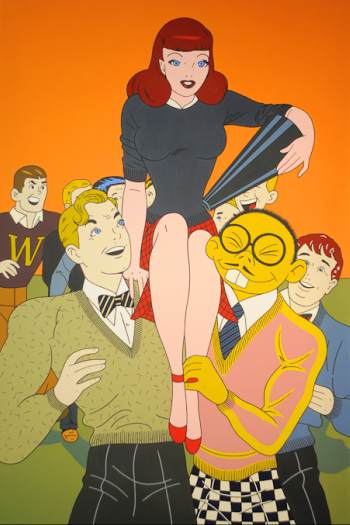 Shimomura paints racist incidents from the racist’s point of
Shimomura paints racist incidents from the racist’s point of
view. The Asian male posing for the camera is a buck-toothed lizard. His yellow hand wraps the slender ankle of an all-American girl. Anyone looking at his paintings is seeing through the eyes of a white person who fears and loathes all others.
Not me, you might say, and you might be right. But you are the one looking.
Shimomura’s cold, flat style — a blend of Pop and Japanese
ukiyo-e — gets inside his hot subject to give it a deadpan edge.
His paintings in his exhibit titled Yellow Terror: Always a Foreigner at the Wing Luke Museum are windows to a demented world.
(Yellow Terror, 2008, acrylic/canvas, 60 x 72 inches. That’s Shimomura low in the center, making slant eyes.)
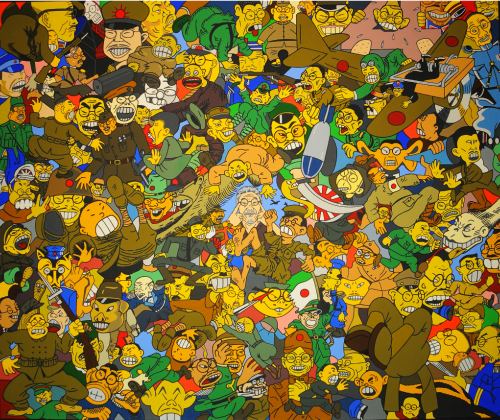 Born
Born
in Seattle, Shimomura’s earliest memories come from Idaho’s Camp
Minidoka, one of the concentration camps built to detain Japanese
Americans on the West Coast during World War II.
Released when
he was 5 years old, he grew up watching his
parents try to rebuild their lives. Even though since 1969 he has
taught at the University of Kansas, he is, at least in Seattle,
considered a Seattle artist, partly due to his wide circle of family
and friends here and partly to his regular exhibits at the Greg Kucera Gallery.
Determined to flourish in a multicultural society, Shimomura likes the
metaphor of a tossed-salad better than a melting pot.
Nothing about him has melted, and that includes his memories.
Shimomura has a lifetime’s worth of experience with racism in all its
guises, from the bungling and insensitive to focused hatred. He
collects its signs and symbols, including movie posters with luridly yellow-faced actors, Jap hunting
licenses, slap-a-Jap cards, Jap dartboards, comics and grotesquely racist masks.
From 1941:
This is to certify that _________ IS ENTITLED TO HUNT THE JAPANESE RAT,
and is hereby warned to exercise extreme caution in approaching this
savage beast: it is a vicious animal and strikes from behind without
warning. This animal has the characteristics of a skunk in appearance
and odor but has an appetite for women and children instead of small
fowls… In shooting this stinkin skunk, aim at its stomach, since it
has lots of GUTS, but no heart or brains.
It’s the kind of material his parents’ generation shunned, but
Shimomura agrees with African American painter Kara Walker, who uses
racist stereotypes in her work in order to defuse them. As Ralph Ellison advised,
Change the joke and slip the yoke.
(A Jap’s a Jap, 2000, acrylic/canvas, 36 x 48 inches.)
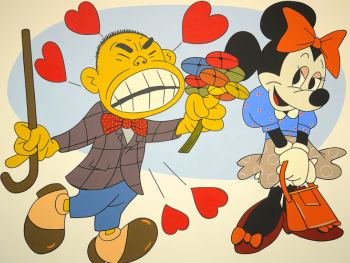 Highlights
Highlights
from that collection are part of his exhibit at Wing Luke. He donated
it to the museum, and his collection of internment diaries to the Smithsonian National Museum of American History.
Anyone
reaching the comforting conclusion that the racism Shimomura explores
is past will shed it when perusing selections from his series, Stereotypes and Admonitions, shown at Kucera in 2004 and in an abbreviated form at Wing Luke. Beside each painting was a note on its origin.
My favorite is not in the show:
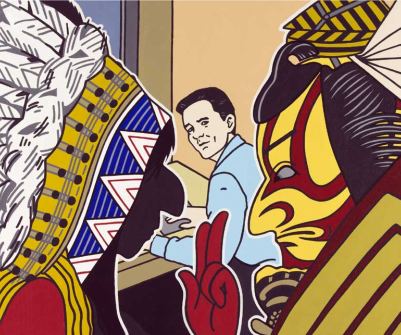 In the 1990s, he walked into the administration building at the University
In the 1990s, he walked into the administration building at the University
of Kansas to sign in his friend, Edgar Heap-of-Birds, who was an artist
in residence. An administrator peered out at them and said loudly to
the receptionist, “I want you to check the IDs of those two characters
out there.”
Both men were startled. “We looked at each other,” said Shimomura.
“What did he say? There’s that moment of incredulity, where you can’t
believe what you just heard.”
In the painting, he’s an old Japanese warrior and Heap-of-Birds is in
full headdress.
Shimomura’s work is deep-freeze end of art’s attempt to grapple with racism. Compared to it, Robert Colescott is sweet and Fred Wilson
heated. We know looking at a Colescott or Wilson where they stand. Even
though Shimomura frequently paints himself into his narratives, he’s
rarely there.
Shimomura:
My emotions aren’t in my paintings. I don’t think
people care about my emotions. Why would they? Painting allows me to
approach this subject in a dispassionate way. It’s almost like
reporting. This is what is out there. It’s dirty work, but I’m
compelled to do it.
When he shows up in his work without feint or painful comedy, it’s a shock. Below, Shimomura with his culturally-imposed shadow:
(Different Citizens, 2009, acrylic/canvas, 36 x 45 inches.)
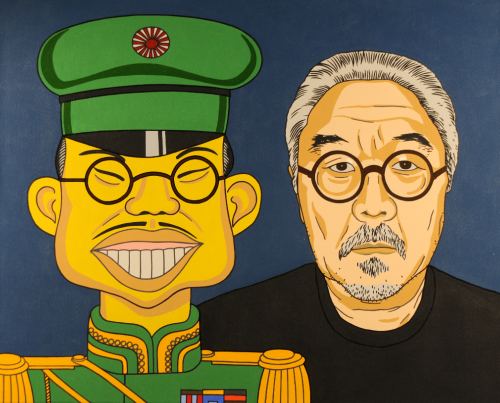 Through April 18. Jen Graves’ review here. Michael Upchurch feature here.
Through April 18. Jen Graves’ review here. Michael Upchurch feature here.



Shimomura is playful or he is calm in his paintings. That’s because he lets the audience do his suffering for him.
What masochist would buy any of these paintings? They tell you to have a bummer day every day.
Leonard. I suspect that Roger’s paintings are more painful for white people than anyone else. For those who deal with racism every day, Shimomura’s work has the force of the factual.
Maybe Shimomura is more interested in saying something that means something to him than making an object to sell. Why is buying or not buying your immediate point of reference, Leonard? Ever heard of looking and thinking for its own sake?
Good point, Ken, a better response than mine.
So I happen upon this painting and I look at it and suddenly I am looking at the painting
Only an art critic who thinks that factory owner Dale Chihuly is a real artist could write crap like that. Perhaps you were multi-tasking (reading SLOG) when you wrote that. Geeeez!
Thanks Regina!!! I went to the opening and Shimomura said his thanks when I told him how I admired his work, and then he promptly took a jello shot. Perhaps I traumatized him?
Anyway about this: “For those who deal with racism every day, Shimomura’s work has the force of the factual.” Apparently so, since the long line of fans kept going and included old and young alike, and we didn’t seem the least bit masochistic.
-Hannah
p.s. I made a shout-out to Shimomura in a weblog about raced bodies in art and film last month, also pointing out my favorite Shimomura works (not in the Yellow Terror exhibit). I love how he recovers these things from history (i.e. Slap-a-Jap ephemera, this Time article) that we would (I hope) think of as CRAZY today, just to be reminded/sobered about the past and the progress we’ve made(I hope) since.
Troubled by racism against you? No problem shift the hateful stereotyped portrayal to women! misogyny always is the trump card men can use to detract from how they have been ‘othered’. But at least it’s interesting and is doing something to stimulate discussion.
I don’t see it, JJ. To portray a self-absorbed woman is not the same as maintaining that all women are self-absorbed.